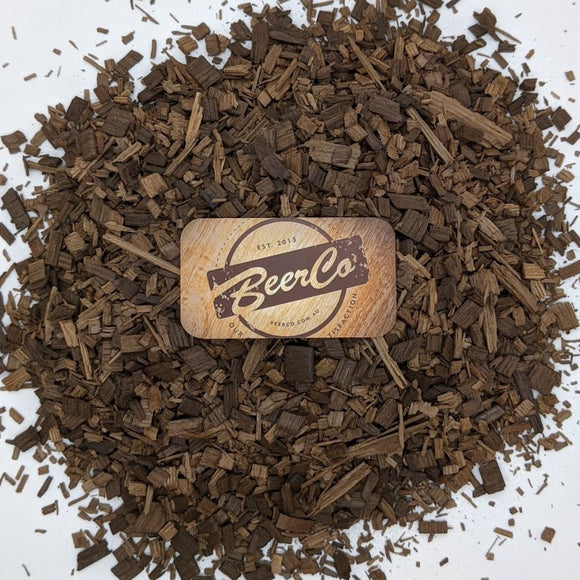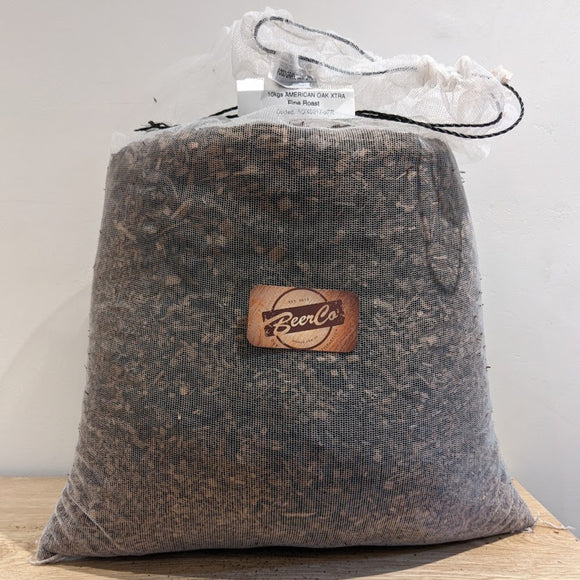The use of oak and other oak products in flavouring beer and spirits has enjoyed a resurgence among home and craft brewers and distillers alike be that for use in Oak Aged Barleywine, Imperial Stout, Brown Ales your favourite big bold clean beers or as a means to impart character depth and dimension to sour beer styles. Oak is most strongly associated with English and some Scotch ales such as Old Ales, Stouts, Porters, Browns, IPAs and some Bitters. Some brewers have used oak in Belgian styles such as the darker Belgian Ales, Farmhouse Ale, or Saison. More rarely you will see oak used with darker central european beers such as Bock or Schwarzbier. In general oak flavouring is associated with darker, older beers or beers replicating historic brewing techniques.
- American oak ‘fine roast’
- Toast: Convection
- Aromatics: Toasted oak and vanilla.
- Flavour: Spicy oak impact. Vanilla and cinnamon. Lactone.
- Mouthfeel: Inky-dark impact with powdery structure.
Form:
- Chips
Toast:
- Convection
- Fine Roast
Type:
- American
Pack Sizes:
- 100 gm net weight
- 1 Kg Net Weight (SAVE 37% OFF 100g Price)
- 10 Kg Net Weight Food Grade Tank Infusion Bag (SAVE 29% OFF 1Kg Price)
Usage Guidance:
20-40 grams per 10 Litres of wine or beer or must.
Seasoning & Toasting
American Oak logs are sawn into planks and seasoned in the country of origin prior to shipment to the Barossa. The planks are stacked to expose the oak to the open air and to the elements (rain and snow) for minimum 24 months.
Seasoned oak planks are then chipped, then batch toasted.
Types of Oak
There are many types of oak though the three most popular are American, Hungarian and French. French oak provides the mildest flavor including some sweet vanilla hints, while American oak gives the strongest oak flavor. Hungarian oak provides a middle ground. The flavor of oak also can be changed by toasting your oak. The dark toasted oak has a more carbonised or caramelised flavor while lightly toasted or untoasted oak has a much more mild flavor. Toasting is usually graded on a light-medium-heavy scale and you can purchase wood chips toasted at these different levels.
Oak Chips
These are the most popular form used in home brewing – typically the chips are sold in a bag and look like wood shavings. The small chips have a large surface area which delivers the oak flavor to the beer quickly. The only disadvantage is that the small chips can be hard to separate from the finished beer, so it is important to have them in a grain or hop bag so they can be easily removed after ageing.
Oak Flavouring Methods
Three major methods are available to home brewers:
Oak Aging
The simplest method – which involves adding the oak chips/spirals/cubes after fermentation while ageing the beer. Also this is the method used with barrels, since you store the beer in the oak barrel. We recommend sanitising the chips/spirals/cubes first by steaming them for 15 minutes to reduce the risk of infection (do not use sanitising solution as it is absorbed by the chips). Most home brewers add their oak shortly after fermentation completes and before bottling (i.e. in the secondary) and leave the oak in there until they achieve the desired taste – sampling every day or two. Some brewers with keg systems also add the oak chips/cubes in the keg itself – containing it in a bag so it will not block the keg dip tube. Oak ageing can take anywhere from a few days to several months depending on the oak used and desired flavor level.
Oak Tea
You can boil the oak to make an oak tea. Simply drop your chips/spirals/cubes in enough water to cover them fully and bring it to a boil for 10-15 minutes. Once the tea is complete you can add it a bit at a time to the finished beer until you achieve the overall beer flavor you desire. Making a tea is much faster than ageing with oak, and also lets you more closely control the flavor.
Liquor Tea
If you are looking to add bourbon, whiskey or your favourite liquor flavor to the beer you can make a tea using liquor instead. In this case you add the chips/cubes/spirals to a small amount of your favourite liquor (possibly diluted a bit with water) and let it sit for a week. Then mix the liquor in with you beer in small amounts until you achieve the desired overall flavor. Obviously moderation is important here as the liquor can easily overpower the flavor of the beer or wood chips.
Oak Aging Spirits:
Aging through oak chips is another easy quick and affordable way to age spirits. Simply take a handful of oak chips and put it in a glass mason jar with your spirit and let it sit for a few weeks. Sample after a few weeks and there after each week until you get what you want. You can also use a propane torch or barbecue grill with tin foil to char your chips and get more of the charred oak barrel taste results. That char helps bring out the full flavor.
When making a dark spirit such as Rum or Whisky, you need to oak and age the Spirit which will contribute colour flavour and aroma to your final product. Dark Spirits are usually oaked at around 63% ABV but can be oaked at lower ABVs if preferred. A good rule of thumb is to use 10g of Oak per litre of Spirit. This can be increased or decreased depending on your desired outcome. A smaller amount for a longer period of time will usually lead to better results. Try leaving to age for at least 3 months! Dilute to drinking ABV and taste it. Bottle or Age for a further 6 to 12 months to see some amazing changes.
Sources, References and Bibliography:
Oak in Your Beer – Oak Chips and Barrel Aging by on FEBRUARY 20, 2012
How can you imitate barrel aging homebrew with oak chips? Brew Your Own,


